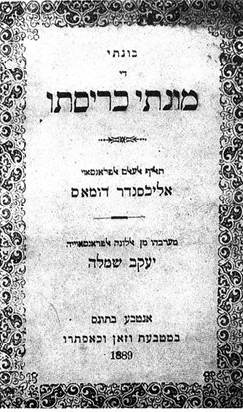History
Before 1901
A Jewish community existed in what is today Tunisia even before Roman rule in Africa. [8] After the Muslim conquest of the Maghreb, this community began to use Arabic for their daily communication. [3] They had adopted the pre-Hilalian dialect of Tunisian Arabic as their own dialect. [3] As Jewish communities tend to be close-knit and isolated from the other ethnic and religious communities of their countries, [6] their dialect spread to their coreligionists all over the country [2] [9] and had not been in contact with the languages of the communities that invaded Tunisia in the Middle Ages. [3] [10] The primary language contact on Judeo-Tunisian Arabic came from the languages of Jewish communities that fled to Tunisia as a result of persecution, like the Judaeo-Spanish-speaking Sephardic Jews [8] This explains why Judeo-Tunisian Arabic lacks influence from the dialects of the Banu Hilal and Banu Sulaym, and has developed several phonological and lexical particularities that distinguish it from Tunisian Arabic. [10] [11] [12] This also explains why Judeo-Tunisian words are generally less removed from their etymological origin than Tunisian words. [13]
The most famous author in Judeo-Arabic is Nissim ben Jacob (990–1062). [14] An influential rabbinical personality of his time, Nissim of Kairouan wrote a collection of folks stories intended for moral encouragement, at the request of his father-in-law on the loss of his son. Nissim wrote "An Elegant Compilation concerning Relief after Adversity" (Al-Faraj ba‘d al-shidda) [15] first in an elevated Judeo-Arabic style following Sa‘adia Gaon's coding and spelling conventions and later translated the work into Mishnaic Hebrew. [16]
The first Judeo-Arabic printing house opened in Tunis in 1860. In 1861, the Tunisian fundamental Pact of 1857 was translated and printed in Judeo-Arabic [17] before its translation into Hebrew in 1862).
After 1901
In 1901, Judeo-Tunisian became one of the main spoken Arabic dialects of Tunisia, with thousands of speakers. [8] Linguists noted the unique character of this dialect and subjected it to study. [8] Among the people studying Judeo-Tunisian Arabic, Daniel Hagege [18] listed a significant amount of Judeo-Tunisian Arabic newspapers from the early 1900s in his essay The Circulation of Tunisian Judeo-Arabic Books. [19] in 1903, David Aydan prints in Judeo-Arabic "Vidu-i bel arbi", a translation of the ritual text recited by the community on Yom Kippur eve. The text is printed in Djerba, a significant point to mention as many works published by the Tunisian Jewish community in Hebrew are printed in Livorno, Italy. [20] Educated leaders within the Tunisian Jewish community, like ceramic merchant Jacob Chemla, translated several works into Judeo-Tunisian, including The Count of Monte Cristo .

However, its emergence has significantly declined since 1948 due to the creation of Israel and the subsequent 1948 Arab–Israeli War. [8] The Jewish community of Tunisia has either chosen to leave or was forced to leave Tunisia and immigrate to France or Israel. [3] [7] Nowadays, the language is extinct throughout most of Tunisia, although still in use by the small communities in Tunis, Gabes and Djerba, [2] [3] [4] and most communities that have left Tunisia now speak the languages of their current country as their first language. [3]
Current situation
Language vitality: Judeo-Tunisian Arabic is believed to be vulnerable with only 500 speakers in Tunisia [21] and with about 45,000 speakers in Israel [22]
Language variations: In Tunisia, geography plays a huge role in how Judeo-Tunisian Arabic varies between speakers. [23] In fact, Tunisian Judeo-Arabic can vary depending on the region in which it is spoken. [23] Accordingly, the main dialects of Judeo-Tunisian Arabic are: [23]
- The dialect of the North of Tunisia (Mainly spoken in Tunis)
- The dialect of the South of Tunisia (Mainly Spoken in Gabes)
- The dialect of the islands off the coast of the country (Mainly spoken in Djerba)
In addition, Judeo-Tunisian can vary within the same region based on the town in which it is spoken. [23]